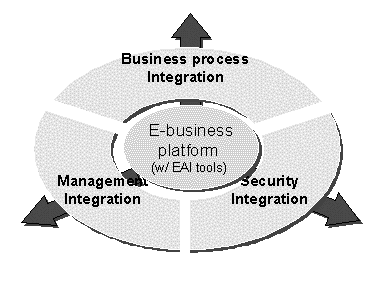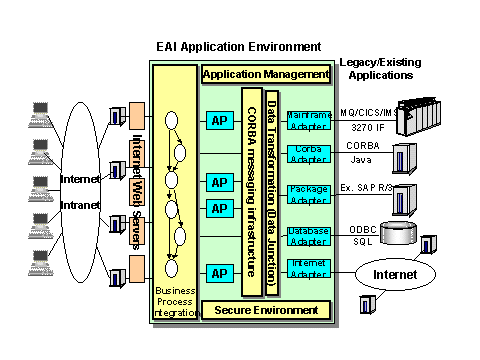
"It is
impossible for ideas to compete in the marketplace if no forum for
their presentation is provided or available." Thomas Mann, 1896
The Extended Enterprise - Application Integration Solutions
Author: Masato Saito
Contributed by Hitachi Computer Products (America), Inc.
Introduction
EAI was widely introduced for effective system construction methodology to utilize existing applications and systems. EAI is often introduced as generic term to integrate number of applications that are any of either already existing, newly developed, or packaged solution customers could buy from software vendors. EAI was introduced effective and quick way of developing e-business service platform without significant development resource needs, moreover it is effective to continue providing the existing service information service offering without interrupting current operation. Most of current e-business system used sort of EAI may be still experimental, opportunistic and immature in terms of reliability, robustness, scalability and continuity of service. If the real mission critical e-business service system, that is operated in 24Hour x 7Days with mass of users in world wide base, should be implemented, additional functionality supporting the core of the e-business applications should be considered. Hitachi is always thinking what should be needed to support such mission critical system and how customers can realize truly trusted information environment. Hitachi also agreed that EAI is effective methodology to construct new e-business application system cost effectively. However, number of additional consideration should be applied for the system. In this paper, what should be considered and how Hitachi can help users to realize such systems.
Why Hitachi choose CORBA technology as a core technology for EAI
Hitachi’s one of the flagship products for e-business platform is TPBroker. TPBroker is CORBA based object request broker with object transaction capability and asynchronous messaging capability. Hitachi developed TPBroker as a core technology of the e-business in which INPRISE’s VisiBroker is used as the base technology. Hitachi thinks CORBA based ORB with transaction capability should be the core massaging bus to support current and future e-business platforms. The reasons why Hitachi think CORBA with transaction is the core technology are;
Future IT system should be layered on top of standard “Component Based” architecture, so that
-
It can utilize off-the-shelf enterprise components or enterprise beans,
-
It can utilize different types of components written in different languages (C++, Java, COBOL)
-
It is relatively easy to realize communication between application and application, once these are defined as components or wrappers with standard IDL(Interface Definition Language). Flexibility is gain for application integration.
Because in distributed system environment many system elements operate independently, timing of communication should be independent of application operation, although consistency of data between applications should be maintained.
-
Asynchronous message linking should be used for the communication between independently operated processes
-
Synchronous Linking with transaction consistency should be used for real time mission critical processed
-
Multiple communication methods should be provided; even within single business processes consist of multiple transaction processes
Since OMG’s CORBA is the core of the e-business system, number of supporting system should also follow the OMG’s standard specification to realize interoperability among other ORB system or through IIOP communication mechanisms.
Hitachi also sees the importance of Java technology as a common programming language for future component based application. Therefore, Hitachi is considering to provide Enterprise Java Beans (EJB) or J2EE technology capability on TPBroker messaging infrastructure.
EAI tool kit
TPBroker is a messaging infrastructure to realize communications between components representing numerous applications. Applications themselves are developed and existing in different environments in terms of operating systems, languages, and data representation of application. So tools to map actual applications to components or objects on ORB and data transformation capability between application interfaces should be provided in addition to the messaging infrastructure. Mapping mechanisms are often called “adapters.” Since there are many kinds of application environments existing in actual applications, it is usually difficult and impractical to provide fixed adapters for the real world applications. Toolkit for developing adapter to fit to the actual application environment should be provided. Adapters need to have functionality to change communication mechanism from something else to CORBA and data format or representation between different applications.
Hitachi provides Adapter toolkit to fit with data transformation capability, such as Data Junction’s tools. Depending on the nature of the integration or the nature of the application to be integrated, other adapter technology or transformation technology may be used. Hitachi’s toolkit architecture allows combining different kinds of adapter and data transformation technologies for EAI development. This flexibility makes users to realize virtually any kinds of application integration based on their requirements.
The extension of EAI
With messaging infrastructure that provides application-to-application communication using ORB technology and adapter to make wrapping application into object or component, the basic EAI framework can be realized. However, it just provides fundamental technology to make application integration possible. If the system using EAI should be robust, secured and reliable enough for a mission critical use, additional functionality should be associated and supported with the framework. This may includes ease of use for end users of such application, security for the content manager, reliability and easiness of operation for system managers or operators, and robustness for all users are the requirements for the REAL MISSION CRITICAL e-business platform.
Three key technologies that Hitachi thinks most important for the real mission critical e-business are the following.
1. Enterprise Business Process Integration
Business processes are getting to be more sophisticated in Internet e-business. Application processes within e-business environment should be designed from the users point of view rather than from an IT management view. Applications usually use EAI technology categorized into two groups. One is hub and spoke type EAI, and the other is workflow type EAI. Hub and spoke is the environment in which each application can receive data or formatted information from any other application through EAI framework. There are no controls of flow existing within each application. On the other hand, within workflow type system, there are sets of applications in which certain flow or sequence of application running is defined or certain conditions are defined for the operation of each application. There need to have some mechanisms to define and control such workflow type system.
Hitachi introduce mechanism to manage business process flow and to define such flow among different application subsystems. The technique to integrate application with flow image is called Enterprise Business Process Integration.
2. Enterprise Security Integration
When we think about application operation before EAI technique is introduced, each subsystem or application was securely managed by its own management mechanism. However, in e-business environment using EAI technique, there are number of subsystems that have own independent security policy existing within single application or a combined subsystem. Users need to access several subsystems without knowledge of the existence of these security policies. Security mechanism to prevent unauthorized access to information resources within different subsystems should be introduced in e-business environment with EAI technique. Hitachi calls this security mechanism to manage security wall and policy over several subsystems as Enterprise Security Integration.
3. Enterprise Management Integration
IT systems are getting more sophisticated, many applications visible to end users consist of several business processes and each business processes itself consists many application programs or processes. It is getting more difficult to solve the IT problems without knowing the relationship between business processes, program resources and configuration within a application sub systems. It is necessary for system management to manage “Application Process Point of View” rather than just “Program Process Point of View,” especially within EAI environments. This is called Enterprise Application Management. Moreover, application management should be consolidated into overall system management operated by tools such as ISM (Integrated System Management) tool. Hitachi calls this integrated management environment for every IT resource including system component, network component, database and application component as Enterprise Management Integration.
Hitachi’s extension of EAI is summarized as the Figure 1

Hitachi’s solution for enhancing e-Business infrastructure
Hitachi is one of the largest computer hardware, computer software and system integration technology provider in Japan, and has numerous EAI system construction experiences in Japan. Based on such experiences, Hitachi has developed very strong and effective tools for implementing the above three key technologies over e-business platforms. The system image of the Hitachi EAI solution is shown in the figure 2.

In this system, CORBA technology is used as fundamental communication infrastructure for application integration. In this system, adapters can be developed using adapter toolkit with wrapping technology or MQ messaging technology integrate existing applications and systems into the CORBA based messaging infrastructure.
Hitachi’s EAI solution is targeting to provide users to realize robust, highly reliable and highly scalable e-business system. Hitachi’s EAI product suite consists of the following software products.
TPBroker: CORBA based ORB with object transaction management capability
TPBroker/AM: AM is asynchronous messaging capability supported on CORBA environment. MQ based system can be communicated with CORBA environment with AM.
TPBroker Security Service: OMG compliant security service to realize secure environment within CORBA and/or EJB based application environment
Hitachi Enterprise Application Manager (HiEM): HiEM is an application management toolkit providing management capability, such as performance and configuration management for CORBA based applications as well as other types of application components.
Work Coordinator: Flexible flow control mechanism is introduced that is OMG and WfMC standard compliant Workflow capability focusing on Application Integration.
EAI Adapter toolkit; This product provide toolkit to develop adapter to integrate application into Work Coordinator environment with data transformation capability to communicate with other application and to integrate the application managed by HiEM application management environment.
Visit the Authors Web Site
![]()

 Search Our Site
Search Our Site
Search the ENTIRE Business
Forum site. Search includes the Business
Forum Library, The Business Forum Journal and the Calendar Pages.
Disclaimer
The Business Forum, its Officers, partners, and all other Home
Calendar The Business Forum Journal
Features
Concept
History
Email:
[email protected]
Graphics by
DawsonDesign
Webmaster:
bruceclay.com
©
Copyright The Business Forum Institute 1982 - 2010 All rights reserved.
parties with which it deals, or is associated with, accept
absolutely no responsibility whatsoever, nor any liability,
for what is published on this web site. Please refer to:
Library
Formats
Guest Testimonials
Client Testimonials
Experts Search
News Wire Join
Why Sponsor
Tell-A-Friend
Contact The Business Forum
Beverly Hills, California United States of America
![]()